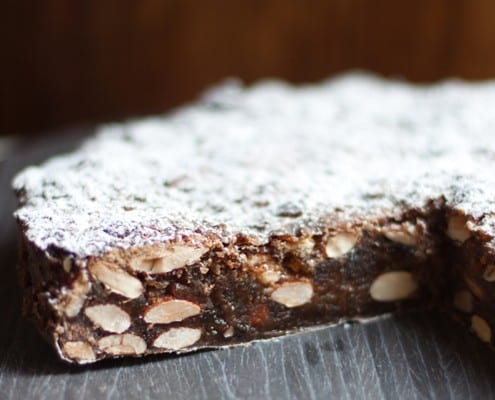Siena’s rustic, medieval flavoured flat cake, panforte, is dense with candied fruit, spices and nuts. The perfect rich winter treat.
By Emiko Davies
Panforte is a rich, flat cake, made dense with whole nuts, copious amounts of spices and candied fruit. These days, it is most often associated with the medieval city of Siena, whose famous cafes or pastry shops like Nannini and Dolce Siena have them piled up in their window displays, tempting passers-by.
Despite what many may think, the spicy cake has its roots in Medieval Italy, where much of central part of the peninsula, from Emilia-Romagna to Le Marche, were fond of this delicacy. It was often prepared in convents and monasteries and is a dish that although now can be expensive, really has its origins in cucina povera. There are various versions of it, such as panpepato (literally, “peppered bread”), but the panforte (literally “strong bread”, alluding to the strong and spicy flavour of this traditional dish) that is so well known now is still a fairly faithful version of the Renaissance recipe, differing only in that flour is now used instead of breadcrumbs.
It’s the perfect thing to allow yourself a sliver of in the late afternoon on a cold day when you need a pick me up and a zing of spices to flush your cheeks. It makes a great Christmas treat, both as a beautiful handmade gift and also to serve in a thin wedge at the end of a long meal. It also happens to be one of the easiest cakes in the world to make and is practically fail-proof.
The only trouble you may have with this recipe is finding the most traditional ingredients, the main one of which is candied melon. For the best cake, it should be an artisan-made candied fruit if possible rather than industrial, pre-chopped candied fruit (it makes all the difference, trust me).
Not having candied melon, you could try using dried figs (a favourite in the Renaissance), or for a more similar texture to the original, you could also use candied cedro. There does actually exist a more delicate version of panforte known as Panforte Margherita, invented in 1879 for a visit of Queen Margherita of Savoy to Siena. It is made using cedro instead of melon and vanilla instead of the characteristic spices. The result is a lighter (in colour and flavour) cake and those that aren’t a fan of the strong spicy flavour of traditional panforte may prefer this version.
Panforte is normally cooked on thin, rice paper wafers, but if you cannot get your hands on these specially produced wafers, a cake tin with a removable bottom or even simple baking paper works just fine.
PrintPanforte
- Total Time: 50 minutes
- Yield: 10 1x
Description
Siena’s rustic, medieval flavoured flat cake, panforte, is dense with candied fruit, spices and nuts. The perfect rich winter treat.
Ingredients
- 400 g or 14 ounces candied melon (or dried figs or candied cedro)
- 50 g or 1.7 ounces candied orange peel
- 350 g or 12 ounces white sugar
- 350 g or 12 ounces blanched, peeled whole almonds
- 150 g or 5.2 ounces flour
- 10 g or 0.3 ounces (or about 2 tablespoons) mixed spices (the traditional mix is made up of 6 g coriander seeds, 3 g mace, pinch cloves, pinch nutmeg)
- 1 tsp black peppercorns (optional)
- 5 g (1 tablespoon) of cinnamon
- icing sugar
Instructions
- Chop the candied fruit into small pieces and set aside. Grind the mixed spice together (I use a coffee bean grinder that I don’t use for coffee or you can try a mortar and pestle, the old fashioned way) and set aside.
- Place the sugar in about 100 ml (3.3 fluid ounces) of water in a saucepan over low heat. Let it dissolve and thicken into a syrup without colouring (it should reach 120 C if you have a sugar thermometer).
- Take the syrup off the heat and combine with the flour, the candied fruit, the whole almonds and spices (minus the cinnamon).
- Pour into a greased, floured round, flat cake tin (the panforte should be about 2cm tall, a tin about 26cm or 10 inches in diameter should do the trick), sprinkle the cinnamon over the top and cook in a medium oven (about 160 C or 320 F) for 30 minutes or until firm. Remove the panforte from its cake tin, allow to cool and cover generously with icing sugar.
- It keeps very, very well, best if it is covered or in an airtight container in a cool, dark place.
- Prep Time: 20 mins
- Cook Time: 30 mins

























Tried it – made it because I wanted to try a non-chocolate siena cake – I think the sugar flour ratio must be wrong. Came out like an anaemic, failed toffee. Sweet and claggy. There was no way it was ever going to look like the picture. No stars for this recipe.
I love panforte, but never made one myself. Looks great!